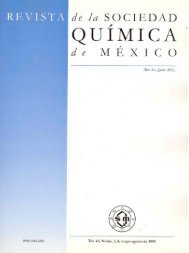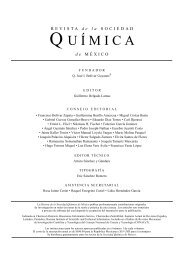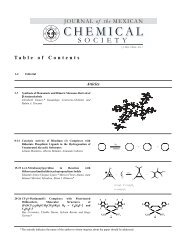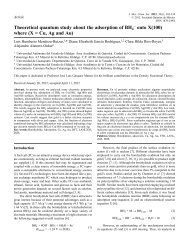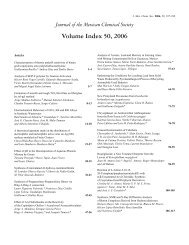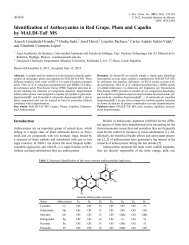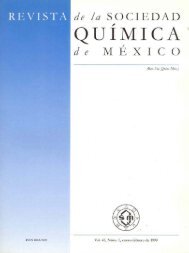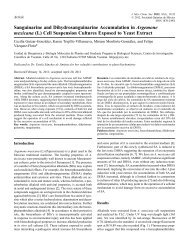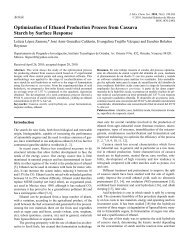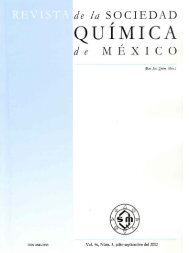SMQ-V047 N-002_ligas_size.pdf - Journal of the Mexican Chemical ...
SMQ-V047 N-002_ligas_size.pdf - Journal of the Mexican Chemical ...
SMQ-V047 N-002_ligas_size.pdf - Journal of the Mexican Chemical ...
You also want an ePaper? Increase the reach of your titles
YUMPU automatically turns print PDFs into web optimized ePapers that Google loves.
112 Rev. Soc. Quím. Méx. Vol. 47, Núm. 2 (2003) Jorge A. Mendoza et al.<br />
efficient differences follow a similar trend in <strong>the</strong> o<strong>the</strong>r conformers.<br />
As expected for <strong>the</strong> amino substituted olefins 7a and 7b,<br />
when an electron-releasing group is introduced into <strong>the</strong> double<br />
bond <strong>of</strong> <strong>the</strong> captodative olefin, both HOMO and LUMO<br />
should increase in energy (Table 3, entry 1 vs. entries 3 and<br />
4). However, for <strong>the</strong> rest <strong>of</strong> <strong>the</strong> olefins, only <strong>the</strong> HOMO was<br />
energetically destabilized, since <strong>the</strong> LUMO energy <strong>of</strong> olefins<br />
3a, 10f, and 10g was lower than that <strong>of</strong> <strong>the</strong> unsubstituted<br />
olefin 1a. It is likely that <strong>the</strong> effect <strong>of</strong> <strong>the</strong> heteroatom on <strong>the</strong><br />
energy <strong>of</strong> <strong>the</strong> FMOs be <strong>the</strong> result <strong>of</strong> an interplay <strong>of</strong> different<br />
factors. The delocalization <strong>of</strong> <strong>the</strong> lone electron pair <strong>of</strong><br />
bromine and sulphur toward <strong>the</strong> π-conjugated enone system<br />
will be less efficient than that <strong>of</strong> <strong>the</strong> nitrogen atom, due to <strong>the</strong><br />
differences in electronic configuration. The inductive effect <strong>of</strong><br />
<strong>the</strong>se electronegative heteroatoms may increase <strong>the</strong> electronwithdrawing<br />
effect <strong>of</strong> <strong>the</strong> beta substituent on <strong>the</strong> electron density<br />
<strong>of</strong> <strong>the</strong> double bond [17].<br />
The delocalization <strong>of</strong> <strong>the</strong> lone electron pair in enaminone<br />
7b was reflected in a shortening <strong>of</strong> <strong>the</strong> C(1)-N and C(2)-C(3)<br />
bonds, and by an increase <strong>of</strong> <strong>the</strong> C(3)=O(4) and C(1)=C(2)<br />
bond lengths [6], as observed for o<strong>the</strong>r analogues by X-ray diffraction<br />
[18]. Similarly, significant delocalization appears in <strong>the</strong><br />
bromo olefin 3a, since <strong>the</strong> C(2)-C(3) bond length is shorter and<br />
<strong>the</strong> C(1)=C(2) bond is longer than <strong>the</strong> corresponding bond<br />
lengths <strong>of</strong> 1a and <strong>of</strong> <strong>the</strong> average values taken from X-ray data<br />
<strong>of</strong> similar functional groups [19] (Table 4). In contrast, <strong>the</strong> X-<br />
ray structure <strong>of</strong> 10f (Fig. 2) provides bond distances similar to<br />
those for <strong>the</strong> β-unsubstituted olefin and for <strong>the</strong> non-delocalized<br />
enone [19] (Table 4). It is noteworthy that <strong>the</strong> bond distances<br />
between <strong>the</strong> atoms <strong>of</strong> <strong>the</strong> aroyloxy group are not really perturbed<br />
by changes in <strong>the</strong> heteroatom at <strong>the</strong> beta position. This<br />
supports <strong>the</strong> idea <strong>of</strong> a non significant interaction between <strong>the</strong><br />
lone pair <strong>of</strong> <strong>the</strong> oxygen atom <strong>of</strong> <strong>the</strong> electron donor group and<br />
<strong>the</strong> double bond, at least, in <strong>the</strong> crystalline state.<br />
According to data in Table 3, one could anticipate a higher<br />
reactivity <strong>of</strong> olefins 3a, 10f, and 10g with respect to 1a in<br />
Diels-Alder cycloadditions with diene 5, since <strong>the</strong> HOMOdiene<br />
/ LUMO-dienophile energy gaps for <strong>the</strong> former dienophiles<br />
are smaller than that found for <strong>the</strong> latter. This expectation<br />
is only partially in agreement with <strong>the</strong> observed reactivity,<br />
since olefin 3a added to 5 under <strong>the</strong>rmal and Lewis acid<br />
catalytic conditions similar to those used for 1a in shorter<br />
reaction times [6]. However, thioalkene 3d, which is analogous<br />
to olefins 10, failed to react even under catalysis. As predicted,<br />
<strong>the</strong> beta amino substituted alkene 7b was less reactive<br />
than 1a, being unable to react with cyclopentadiene (12) [6],<br />
which is considered a very reactive diene.<br />
The unreliable prediction <strong>of</strong> <strong>the</strong> reactivity <strong>of</strong> olefins 10 by<br />
FMO <strong>the</strong>ory may be attributed to steric hindrance [20], which<br />
would counterbalance <strong>the</strong> electronic effect, as suggested previously<br />
by establishing a correlation between <strong>the</strong> reaction rate<br />
and LUMO energies <strong>of</strong> olefins 1a and 6 [11]. In addition, it<br />
has been found that <strong>the</strong> FMO model fails to account for <strong>the</strong><br />
regioselectivity in Diels-Alder reactions with trisusbtituted<br />
dienophiles or with phenylthiosubstituted dienes [21], or in<br />
1,3-dipolar cycloadditions <strong>of</strong> nitrile oxides and nitrones with<br />
olefins such as 1a [3c].<br />
It is noteworthy that, under <strong>the</strong>rmal and catalyzed conditions,<br />
<strong>the</strong> regioselectivity found in <strong>the</strong> Diels-Alder addition <strong>of</strong><br />
dienophile 3a with isoprene (5) was similar to that observed<br />
with <strong>the</strong> β-unsubstituted olefin 1a [2a, 6]. From <strong>the</strong> FMO<br />
viewpoint, regioselectivity can be predicted on <strong>the</strong> basis <strong>of</strong> <strong>the</strong><br />
atomic coefficient differences for <strong>the</strong> appropriate frontier<br />
orbital interaction: HOMO-diene/LUMO-dienophile, under<br />
NED control [14a, 14b]. It can be observed from Table 5 that,<br />
for olefin 3a, <strong>the</strong> relative magnitude <strong>of</strong> <strong>the</strong> LUMO coefficient<br />
in <strong>the</strong> monosubstituted terminus <strong>of</strong> <strong>the</strong> double bond is larger<br />
than that <strong>of</strong> <strong>the</strong> geminally disubstituted carbon. In comparison<br />
with <strong>the</strong> LUMO <strong>of</strong> olefin 1a, <strong>the</strong> difference in coefficients C 1<br />
and C 2 for this olefin and bromo olefin 3a are analogous,<br />
hence a comparable regioselectivity should be observed,<br />
which is, indeed, experimentally found. Thus, for diene 5,<br />
which has <strong>the</strong> HOMO largest coefficient in carbon C-1, a preferred<br />
interaction with <strong>the</strong> largest coefficient on <strong>the</strong> double<br />
bond <strong>of</strong> <strong>the</strong> dienophile agrees with <strong>the</strong> para orientation as <strong>the</strong><br />
major regioisomer.<br />
Polarization <strong>of</strong> <strong>the</strong> π-system in <strong>the</strong> HOMO for <strong>the</strong> amino<br />
olefins 7a and 7b, and for <strong>the</strong> thio olefins 10 is towards <strong>the</strong><br />
substituted captodative carbon <strong>of</strong> <strong>the</strong> double bond (Table 5).<br />
The larger difference in coefficients (∆C i ) <strong>of</strong> <strong>the</strong>se alkenes<br />
with respect to olefin 1a reflects <strong>the</strong> electron-donor effect <strong>of</strong><br />
<strong>the</strong> heteroatom in beta position. In contrast, <strong>the</strong> opposite<br />
polarization is found for <strong>the</strong> LUMO, where <strong>the</strong> larger coefficient<br />
is located in <strong>the</strong> monosubstituted carbon atom (C 1 ) <strong>of</strong> <strong>the</strong><br />
double bond.<br />
Conclusions<br />
The stereoselective syn<strong>the</strong>sis <strong>of</strong> new β-heteroatom substituted<br />
captodative olefins, including amino compound 7a, and sulphur<br />
derivatives 10a-10h, was feasible through three analogous<br />
routes. The common feature among <strong>the</strong>m involved <strong>the</strong><br />
replacement <strong>of</strong> a leaving group at <strong>the</strong> beta position <strong>of</strong> <strong>the</strong><br />
olefin by <strong>the</strong> corresponding amino or thio compound. Both<br />
bromo and dimethylamino were efficient as <strong>the</strong> leaving<br />
groups in <strong>the</strong> starting activated substrates 3a and 7b, respectively.<br />
The former underwent nucleophilic attack <strong>of</strong> alkyl and<br />
aryl thiols or <strong>the</strong> sodium salt <strong>of</strong> some <strong>of</strong> <strong>the</strong>m in good yields.<br />
The Z configuration <strong>of</strong> <strong>the</strong> double bond was established by<br />
NMR and X-ray crystallography. A comparison between bond<br />
distances by X-ray crystallography <strong>of</strong> different β-substituted<br />
and unsubstituted olefins seems to correlate with <strong>the</strong> delocalization<br />
effect <strong>of</strong> <strong>the</strong> heteroatom lone electron pair for <strong>the</strong><br />
bromo and amino β-substituted olefins.<br />
Ab initio calculations <strong>of</strong> FMOs <strong>of</strong> trisubstituted amino<br />
olefins 7a and 7b showed an increase <strong>of</strong> HOMO and LUMO<br />
energies with respect to <strong>the</strong> unsubstituted 1a, as expected for<br />
<strong>the</strong> perturbation <strong>of</strong> <strong>the</strong> π-orbital by an electron-donating<br />
group. The presence <strong>of</strong> a bromine atom and alkyl and aryl thio<br />
groups in olefins 3a, and 10a, 10f, and 10g, however, pro-




